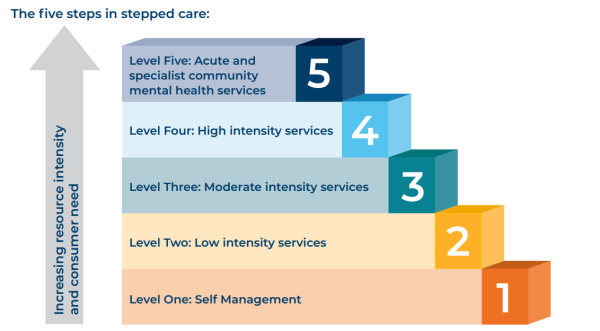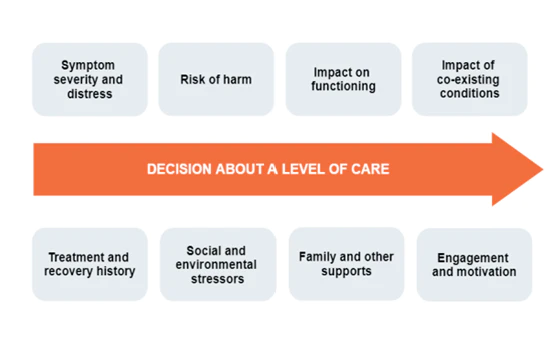A stepped care approach to mental health service provision
A stepped care approach to mental health service provision involves the following elements:
- stratification of the population into different 'needs groups', ranging from whole of population needs for mental health promotion and prevention, through to those with severe, persistent and complex conditions
- setting interventions for each group - this is necessary because not all needs require formal intervention
- defining a comprehensive 'menu' of evidence-based services required to respond to the spectrum of need
- matching service types to the treatment targets for each needs group and commissioning / delivering services accordingly.

Pictured: the five steps in stepped care.
An individual is matched to the intervention level that most suits their need. They do not have to start at the lowest, least intensive level of intervention in order to access a different 'step'. Rather, they have their service level aligned to their requirements at the time of entering the mental health system.
Learn more about each level by clicking on the headings below. Please note that each situation is unique, and you can also apply your clinical judgement for treatment.
Why use the IAR Decision Support Tool?
-

Consistent and transparent referrals
The IAR-DST is being progressively introduced across federal and state mental health services, harmonising the approach to referrals and service provision right across the sector.
-

Improved patient outcomes
Effective communication of a consumer's circumstances will ensure that they are matched to the most appropriate service for their needs, minimising their time within the primary care system while maximising their opportunities for improved health outcomes.
-

Flexible clinical decision making
The IAR-DST is used in conjunction with other standardised assessment tools and clinical judgement to help the consumer make the most appropriate plan, while being able to flexibly adjust treatment needs in response to changes in their circumstances.
-

Improved workflow
Integration of the IAR-DST within existing primary care systems and mapping of available services to each level of care will streamline decision-making processes and reduce overall administrative load.

